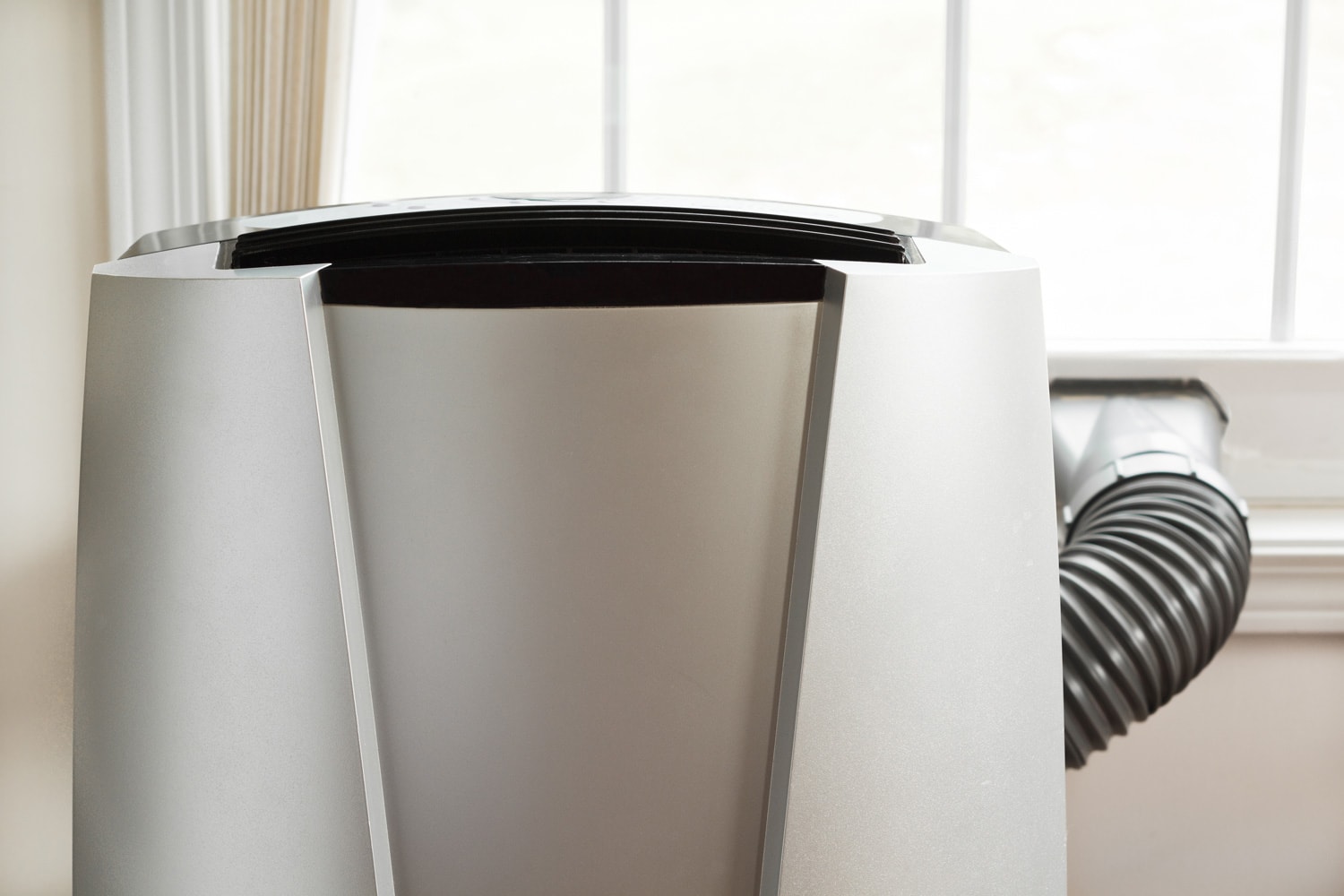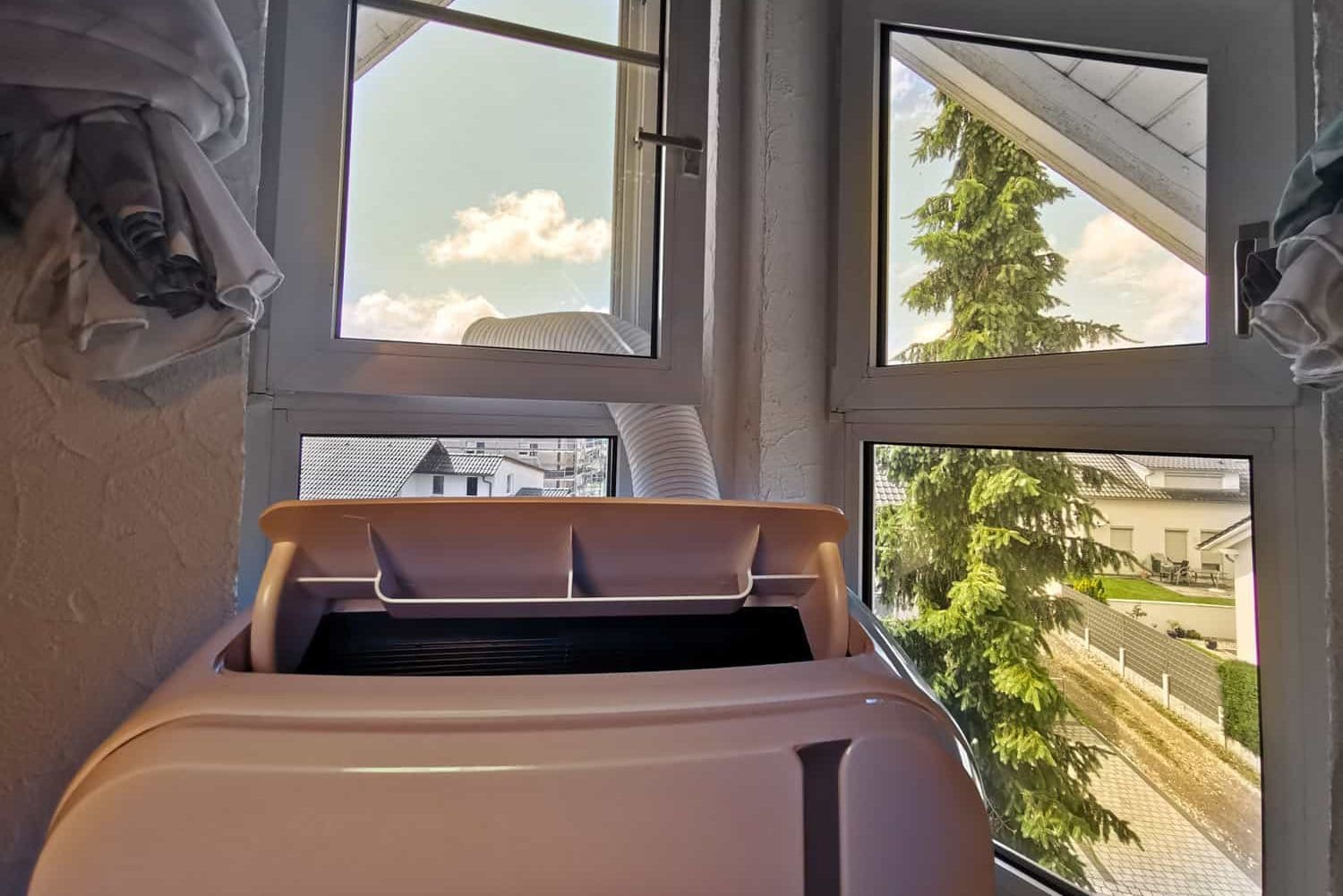Are you considering venting your portable air conditioner through a window screen, perhaps one with a sliding door or crank?
It isn’t always the top choice, but with the right methods, it can work wonders. Here's a quick rundown of the steps involved:
- Align the sealing plate with your sliding window.
- Attach rubber and foam seals for snugness.
- Secure the hose firmly to the plate.
- Address any gaps and consider stability enhancements.
Stay tuned for a deeper dive into efficient portable AC installation!
So, Can You Really Vent a Portable Air Conditioner Through a Screen?
Yes, it's possible to vent a portable air conditioner through a screen.
However, the airflow may have some sort of resistance when opting for this venting process.
To ensure good airflow, you'll need to pay attention to the screen's material and structure (more on this later).
When to Vent a Portable Air Conditioner Through a Screen?

Venting a portable AC unit through a screen is not ideal, as it can make your air conditioner less effective.
Even so, it can still work very well in a pinch depending on certain circumstances.
Most consumers usually remove the screen to vent their portable AC. But there are certain situations where removing the window's screen is not an option.
If that's the case, you'll need to consider the following factors:
Type of Screen
The first thing you need to consider is the screen's type or structure.
While thick screens will obstruct airflow, thin screens will maximize the airflow. It's always better to vent your air conditioner through a thin screen.
Material Considerations
The screen's material is also a crucial part. In the screen venting process, it's given that the airflow will get across some sort of resistance.
With a screen made of mesh, there will be plenty of space for the passage of airflow.
If the mesh doesn't have enough empty space, having the air pass through the screen is definitely not feasible.
If the mesh material is Nylon, then venting an air conditioner through it is not a good idea.
Nylon is highly susceptible to heat, so it will only get damaged over time. Thus, it's best to vent your AC only if you have a steel screen.
Screen Maintenance
Generally, your screen should also be clear and clean before you can vent your unit through it.
The screen will eventually have dust and debris buildup from the airflow of the air conditioner exhaust.
Thus, you should check your screen at least once a week and clean it when it gets dirty.
How to Vent Your Portable Air Conditioner Through a Sliding Window Screen?
Aside from considering the screen's material and structure, the venting process also has a significant effect on the air conditioner's performance.
Follow the steps below to vent your portable air conditioner through a screen of a sliding window.
Tools/Materials You'll Need
- Scissors
- Measuring tape
- Screwdriver Phillips head
- Foam weather seal
- Rubber weather seal
Step by Step Guide
Here are the simple steps that you can follow when venting a portable air conditioner through a screen:
- Make sure that the sealing plate is a perfect fit with your sliding window's length.
- Attach the rubber and foam weather seals to the window sealing plate.
- Attach the sealing plate to the corner of your sliding window.
- Place the hose in and press down firmly until it locks with the sealing plate.
- If there are gaps at the top of the hose, cut some foam pieces and insert them on the edges.
- You can make some adjustments depending on your convenience, such as adding a piece of wood as a window stopper and the like.
Watch the video below for a detailed illustration of the steps we have outlined above:
Keep in mind that the venting process will vary depending on your window type and venting kit.
The important thing is that the unit is properly vented, making the appliance highly efficient.
How to Vent Your Portable Air Conditioner Through a Crank Window with Screens?
Crank or casement windows can be a bit challenging when installing a portable air conditioner, but with the right approach, it's entirely feasible.
Tools/Materials You'll Need
- Plexiglass or plywood
- AC exhaust hose
- Weather stripping
- Screws or additional strips
- Screen replacement kit (optional)
Step by Step Guide
Here's what you need to do to install your portable AC in a Crank or casement window:
- Begin by measuring the height and width of your window.
- Choose between plexiglass (for transparency) or plywood. Plexiglass is transparent, allowing light to enter, making it a preferred choice for many.
- Shape material to fit window dimensions. You'll also need to cut a hole for the AC exhaust hose, considering its diameter.
- Either temporarily remove the screen or cut a hole to align with the exhaust hose's position.
- Apply weather stripping around the edges of the plexiglass or plywood. This ensures no warm air seeps in, providing an energy-efficient seal.
- Open the crank window, position the screen (if you're using it), and then place the plywood or plexiglass, ensuring a snug fit.
- Close the window to hold everything in place.
- Now, attach one end of the exhaust hose to the AC and guide the other end through the hole in the board or plexiglass.
- With the help of screws or additional strips, secure the board or plexiglass to prevent any movement or air leaks.
- Once everything is set up, turn on your AC.
⚠️ Note: Make sure to monitor the setup for the first few hours to ensure there's no undue stress on the screen or that condensation doesn't build up excessively.
Learn more here: How To Vent My AC Through A Crank Window?
Here's a helpful video to guide you throughout the process:
Do I Have to Remove the Window Screen for My Portable Air Conditioner?
As mentioned, it's not necessary, but it's recommended. Keeping the screen can restrict airflow and reduce the AC's efficiency.
Over time, dust and debris may accumulate on the screen, further impeding the flow. If removing the screen isn't feasible, ensure it's thin and clean to maximize airflow.
Periodically checking and cleaning the screen will also help maintain optimal performance.
How Can I Maximize Airflow When Venting My Portable AC Through a Screen?
There are different methods you can choose from in order to maximize the airflow in your unit's ventilation.
Method 1: Direct Exhaust Venting
Adjust the exhaust so that the airflow directly passes through the screen.
With this method, you can prioritize regular maintenance to prevent airflow obstruction from dust accumulation.
Method 2: Plywood Plank Exhaust
In this method, you'll have to cut a plywood plank matching the exhaust tube's width and the screen's height. Here's what you need to do:
- Measure the exhaust tube's width and the screen's height.
- Size the plywood to match the exhaust tube's width and the screen's height.
- Secure the plywood plank to the side of the screen where it closes, creating a new surface.
- Measure the exhaust tube's diameter, then cut a corresponding hole in the plywood plank.
- Insert the tube into the plank's hole, ensuring a snug fit.
- That's it! Now you have a perfect exhaust system!
The great thing about this setup is that it's not high maintenance, and there won't be a loss of airflow either.
It will also prevent your unit from overheating and will maintain a cool and moisture-free room.
Method 3: Using Add-Ons or Extensions
Invest in add-ons to increase the exhaust area and counteract airflow resistance caused by screen mesh. This method focuses on maximizing airflow through extension tools.
You simply need to determine the airflow reduction from the window screen.
So, if the mesh blocks 60% of airflow, use an extension to expand the exhaust by 200%, restoring airflow to full capacity.
What Are Portable Air Conditioner Window Vent Kits?
The purpose of portable AC window vent kits is to connect it to a hose and install the unit to the nearest window.
The concept of portable AC units with window vent kits makes the ventilation process easier, eliminating the need to hire a professional.
Most units have a window venting kit with a hose and sealing plate. It can also come with other materials needed for the installation.
You'll have to go by the user's manual, but you may need to make changes or adjustments depending on your window's requirements.
If your unit doesn't have one, we recommend checking out this Gulrear portable AC window kit for a reliable option.
See this portable AC window kit on Amazon.
Is it Possible to Vent a Portable Air Conditioner Without a Window?
Yes, it is possible to vent a portable air conditioner without a traditional window, but it requires alternative methods.
If your space lacks a suitable window for venting, you can consider other options, such as using a sliding drop ceiling, a dryer vent, or drilling a hole through a wall.
Each alternative method has its own challenges and considerations, so it's essential to assess the feasibility and safety of these options carefully.
Can You Vent a Portable Air Conditioner Through a Sliding Door?

Yes, you can vent your portable AC through a sliding door as long as you have available a vent kit that is designed precisely for its greater width.
Take note that your door should lead into the open air, like your backyard.
If the door just leads to another room, the proper cooling process might be a challenge.
Related content: Can I Vent A Portable AC Into The Cold Air Return?
Can Install a Portable Air Conditioner on a Screened in Porch?
Using a portable air conditioner on a screened-in porch is an option, but there are essential factors to bear in mind.
First, the size of your AC unit should correspond to the porch's size for efficient cooling without wasting energy.
Proper airflow and ventilation are crucial - ideally, position your AC near an outlet and direct the exhaust towards open space.
Given the nature of screened-in porches, they often present more gaps than typical rooms, so it's vital to seal these gaps.
Lastly, if your porch might be exposed to elements like rain, always opt for weatherproof electrical outlets to ensure safety.
What Happens if You Don’t Vent a Portable AC Unit?

Your unit will be less efficient if you don't vent it. The main reason for venting your air conditioner is to remove the heat that is pulled out from the air.
If there is no ventilation port for the exhaust, the hot air will just flow back into the room, making your environment hotter.
In addition, warm air means higher humidity, so an unvented AC can lead to an increase in your room's humidity levels.
Aside from the fact that having humid air is an inconvenience, high humidity can also decrease the lifespan of your unit.
The above terms will only apply, of course, to units that are designed for venting. There are portable ACs that are ventless, running with the use of ice and water.
You might also like: Water Dripping From AC Vent In Ceiling—What To Do?
In Closing
Navigating the world of portable air conditioning units can be intricate, especially when finding the most efficient way to vent them.
We talked about how you can vent an AC through a screen, how to do it with different windows, and why your screen type matters.
Plus, we've given tips on how to get the best airflow and answered some other common questions.
Did you find your answer? We'd love to hear your thoughts, so please comment below. Your feedback helps us give you more of what you need.


